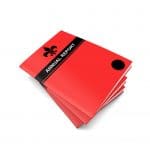Don’t get us wrong: Dream Big. But before you set out on an adventure to grow your wellness business into a multi-state, thousand-franchise juggernaut, make sure you’ve equipped yourself for the journey.
Here’s how ANY wellness business can use smart business planning to ensure it can survive the onslaught of challenges it will face in reaching ambitious goals.
Recently I’ve been speaking with friends of a similar age and inclination about planning our outdoor “bucket list” adventures.
For one of us, it’s hiking the entire 2184-mile length of the Appalachian Trail. For another, it’s running the Marathon des Sables, a 143-mile ultramarathon set in the Sahara Desert and billed as “the toughest footrace on earth.” For another, it’s a buddy-run across the continental United States (NOTE: I finished that one in April 2021).
Sounds epic, right? But there’s a big difference between hiking the Appalachian Trail and DREAMING of hiking the Appalachian Trail.
Many wellness business owners have great ideas and ambitious plans. And to their credit, they GET the idea of hard work. We’ve never seen people work harder! But as anyone who’s done something epic will tell you, it’s more than hard work: it’s a lot of planning, patience, and nimbleness of strategy as well. Here are ten key principles to apply to ANY epic project, whether it’s running across the country, raising $100 million in capital, or “just” massively franchising your business.
1. Thoroughly assess everything before you start
If you’re planning to run across the United States, you have to know what city you’ll start in, what city you’ll end in, and what cities you’ll pass through. You’ll need to know what time of year you’ll start, and how to pack and dress for a run that will ultimately take you at least a couple of months of nothing but running. You’ll have to decide, based on the time of year, whether it makes more sense to run west-to-east or east-to-west. You’ll need a SAG (support, aid, and gear) vehicle or a network of friends to meet you in each city to resupply your food and water. You’ll need first aid. You’ll need lots of sunscreen and Body Glide. And you’ll need a route planned in advance.
That’s if everything goes well, you don’t cook in the afternoon sun crossing Nebraska, you don’t get bitten by snakes or fire ants, and you don’t hit detours, bad weather, or catch the flu.
Now look at your fitness or wellness business. If you’re planning to expand Bollywood Fitness Dance from Sunnyvale, CA to 800 locations nationwide, you’ll need to know the logistics of setting up a store in another town, first inside California and later outside the state. You’ll need to understand your target demographic in detail and where they’re concentrated outside your immediate area. You’ll need to understand franchise costs and contracts, set fees, and carefully vet, onboard, and train new franchisees. You’ll need to look at membership databases, sales and marketing literature, and develop a sustainable sales and marketing budget and growth plan.
If you don’t, there’s a chance you may find yourself locked outside your store, loading boxes of printed materials and dance videos into your trunk.
2. Stock up on essentials
For epic expeditions, that means food, water, and supplies that don’t weigh so much that they make progress impossible. For your business, essentials are the tools and skills it will need regularly, regardless of the challenge, such as basic accounting and bookkeeping, record keeping, contracts, and operations management.
Your business will always need someone who understands its finances. It will always need some legal expertise. And while you may not be an accountant or lawyer, you DO need to know how to handle partnership contracts that fall apart at the worst time, and whether the money you’re spending on franchising in another eight towns is going to be reasonably offset in relatively short order by additional income.
Like the epic adventurer, don’t skimp when it comes to the absolute necessities. Just as Sahara ultramarathoners suffer when they pack more clothes than water, your business will suffer if it spends all its money on advertising and comes up short on its resources for business management, operations, or financial management.
3. Don’t carry anything you don’t need
There’s a delicate balance that just about every expedition strikes: taking enough food, water, gear, and first aid to bed down safely for the night, while not adding weight to panniers, not overbalancing backpacks, and not taking two tools when one can do two jobs.
The same is true of your business. Do you really need those 1,000 photo-quality full page color handouts for the trade show, or will a half-page or postcard-sized black-and-white semigloss handout with an enticing message and a website QR code do the same job? Can you do without the handouts? Do you need 3,000 square feet of premium storefront, or can you share space with another business or take large classes outside (for instance, to a neighborhood park)?
Try to imagine how you’d run your fitness or wellness business if you had half the resources you actually have. Then run it as if that were the case. When the inevitable happens, you won’t be weighed down by non-necessities, and you’ll have extra capacity.
4. Plan for delays, detours, and dead ends
Which brings us to… the inevitable. Sooner or later every expedition hits a snag. For my friend’s recent 300-mile run, part of his planned route was under construction, and detours led him twenty to thirty miles out of his way, along sun-baked country roads far from civilization. He arrived at his daily 40-mile check-in point late, extra tired, overheated, low on water, and desperate to use the bathroom.
My friend asked himself what he would have done differently. He said that he would not skip the early refueling stops the next day and the next time around. He stopped at a local REI that evening and picked up a desert running hat with a “Kalahari” flap to protect his neck from sunburn. He unloaded some just-in-case supplies from his backpack. Each day after his run, he scanned Google Maps for alternate routes and aid stops for the next day. And he informed friends in the area that he might need additional support. In the end, he didn’t find alternate routes (in rural Texas, there really aren’t any), but he had a plan, and a volunteer SAG crew showed up to refill his water, ice, running gels, and sunscreen for the stretch from Temple to Waco, all for the low price of a selfie.
If your fitness business launches its new programs on time, it will be not just a miracle, but a statistical anomaly. Nearly every business experiences delays. Permits not being granted in time for a holiday-specific planned grand opening. Sewer problems during store renovations. Discovering that a cigar shop has moved in two stores down from you and people are avoiding your entrance because of it.
Whatever it is, work it into your plan, so that even if permits are granted late, the entire strip mall smells like rotten cabbage (except for the cigar shop), and you have to argue with the landlord, you have a “Plan B” and the show can go on.
5. Rest when you can
Every gran fondo cyclist, ultramarathoner, or Ironman competitor knows that if they don’t stretch their legs, rehydrate, or take advantage of an aid station when they need it, they’ll eventually succumb to leg cramps, heat exhaustion, or fatigue. The more ambitious the event, the more important rest is.
Running a successful business is tiring, and growing one is exhausting.
You may be able to work on adrenalin alone for the first few months, but even if you are successful at seeing your ambitious plans grow fruit — in fact, more likely if you are — you’re going to need to “recharge your batteries” at some point. You MUST have a plan for how your business will run when you’re on vacation, and you MUST take a vacation.
Like exhausted expeditioners, tired business leaders make stupid mistakes.
Don’t let that happen to you.
6. Plan for the (business) seasons
In planning a bike ride or run across the United States, one thing you have to consider is weather.
If you average 30 miles a day, running across the U.S. takes about 100 days. If you start in the Pacific Northwest in late spring to avoid icy temps, it will be late summer — and hot — by the time you hit the east coast. If you take a southern route to avoid the freezing rain in the mountains, it will be even hotter as you head across the Plains.
Similarly, your wellness business needs to plan well in advance how it’s going to spend its resources in the off season to be ready for times when things get busy. Fitness has a natural cycle that tracks with the seasons. If you cater to runners, the busiest time is usually the cooler months; for cyclists and swimmers, it’s summer; for triathletes, spring and fall (when water temps and outdoor temps are both fairly tolerable). If your business caters to hot yoga, summer might be your busiest season. For tai chi, perhaps spring or fall. Weight loss — the “family food fest” season of late fall and winter.
You should know when, how, and where your business will invest in its relatively idle time, when it has more capacity than income.
If you don’t plan in advance for the business seasons, you may find yourself with low or nonexistent enrollment in key programs, or over-spending on marketing at the wrong time of year.
7. Plan for cascading problems and “worst case” scenarios
If you’re planning a 100-mile trail run in the American Southwest, you have to think about how one bad outcome might lead to another.
Let’s say you lose the trail (it happens fairly often), and you run an extra 10 miles to try to re-connect to it (this also happens fairly often). Crossing that extra 10 miles in the Arizona heat, you drink more of your water. You spend more time in the hot sun, you sweat more, and you overheat more. Dehydration aggravates the leg craps that were dogging you since mile 35, so you decide to walk some of it. That means more time in the hot sun, more water consumed, and arriving late at already-depleted aid stations.
It’s easy to see how simply getting lost could lead to disaster. It’s no different for a fitness or wellness business.
You budget for a big show that’s your debut onto the national fitness scene. One of your two partners gets out of joint about how to divvy up sales leads. The other has problems shipping supplies to the convention center and shows up late. You’re left there with a box of literature and no product samples, having spent thousands of dollars (half your year’s marketing budget) just to show up.
The money’s spent. At least you have a box of really, REALLY nice sales literature.
Good planning would suggest that you think in advance about how you’ll use the show materials in other ways; that you budget less for showy, less hail-Mary events; and that regardless of partners, you plan on how you’d handle the next show all by yourself.
You’ll sleep better when you know you have enough water to run an extra 10 miles, and enough cash to spend on mundane day-to-day things like email newsletters, social media outreach, or neighborhood flyers.
8. Be ready to exploit unexpected opportunities
So far we’ve talked mostly about how to plan for the worst. But planning for unexpected best outcomes is also necessary. This doesn’t mean you should count on good luck. But you should know what to do with it when it comes.
A friend of mine who was running across the US stumbled across a number of summer festivals in small towns. As he told his story about running across the country, a few food vendors offered free meals and loaded his pack with fresh fruit in exchange for a selfie and a shout-out.
Learn to recognize opportunities to work with those who can help you with venues, connections, and leads. Learn how to BE that opportunity for others, and you may find it reciprocated.
9. Don’t just plain to fail, plan for AFTER the failure
Plan “C” is worth its weight in gold.
A few years ago, I completed my very first century (100 mile) bicycle ride, a timed event in which I risked a DNF (Did Not Finish). At mile 99, with 10 minutes left, I blew a tire.
I knew as a runner that I could cover the last mile in less than 10 minutes. Change a tire in seven minutes, then ride the last mile? Not so certain. I had worried all night that something might go wrong during the ride, and it did. It just wasn’t what I thought it would be.
So I ran with the bike at my side and crossed the finish line 9 minutes later. Success was not about my ability to ride a bike with strength and efficiency. It was about adaptability.
Your business planning should include a review of how key jobs will get handled when things go thoroughly bad. A clear sense of purpose, adaptability to circumstances, and consideration of what your options really are will keep you rooted in reality and help your business survive.
Which brings us to…
10. At each milestone, re-fit your plan to the reality around you
The consequences for your fitness or wellness business of planning something epic can be classified into a handful of categories:
- You succeed beyond your wildest dreams and find yourself suddenly having to ramp up capacity to deal with an onslaught of customers
- You succeed your goal of growth or expansion, but your budget for accommodating that success is stretched almost to the breaking point
- You find yourself miles away from where you planned to be, but basically doing OK
- You are lost
- You find yourself far short of where you planned to be
- You find yourself where you expected, but late and desperately short of resources
Success and failure are not circumstances: they are what we MAKE of circumstances.
Look around you. Assess your business’s exposure to critical risks, wrong turns, and opportunities as you flesh out your dreams in the light of day. Can you adapt quickly? Do you want to? What will happen if you do? The most critical elements of success at any epic enterprise are preparation, understanding what’s at your disposal, and planning for contingencies.
The more your wellness business has those covered, the less likely it will find itself alone in the desert.




